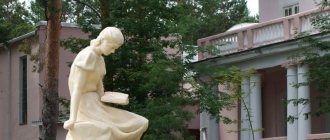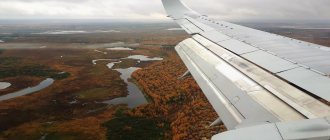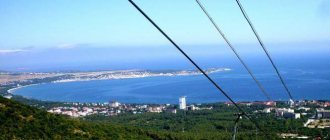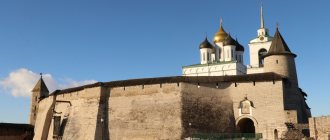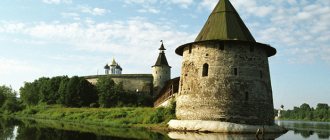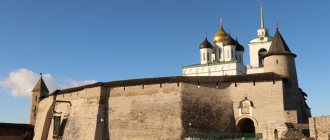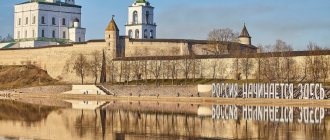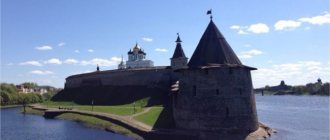| First day Second day Stories, routes and tips from tourists Where to stay in Pskov Excursions from Pskov for 2 days |
Pskov for 2 days is a fascinating journey through ancient Russian lands. Tourists will find here the towers of the ancient Kremlin, centuries-old churches and UNESCO World Heritage Sites. Here you can plunge into the history of the past, when important issues were resolved at the veche, and not far from Pskov the future princess Olga grew up, taking revenge on the Drevlyans for the death of her husband, Prince Igor. For 2 days in Pskov, get ready to see ancient frescoes, fortress walls, chambers of famous families and landscaped embankments.
Pskovsky Krom Photo: © Victor Bashkir
First day
One day is worth visiting the main attractions of the city. You will walk through the old districts - Zapskovye and Zavelichya. The territories got their names from the rivers - the Pskova and Velikaya pass through here. On the cape, where one river flows into another, the Pskov Kremlin and the historical center are located. A 2-day excursion to Pskov is not complete without a walk around the Kremlin and a tour of its towers.
Spaso-Mirozhsky Monastery
Start your walk with a visit to the Spaso-Mirozhsky Monastery , recognized as a UNESCO site. On its territory you can see unique frescoes of the 12th century, preserved in the Transfiguration Cathedral . Byzantine artists were invited to paint the walls. The cathedral itself in shape symbolizes an equal-ended Orthodox cross. Now the former temple is a museum, you can visit it in dry weather. The monastery complex includes a functioning church and a number of other buildings.
Details: Spaso-Mirozhsky Monastery
Spaso-Mirozhsky Monastery Photo: © Victor Bashkir
Olginskaya embankment
From the monastery follow the bank of the Velikaya River to Olginskaya Embankment . There are several interesting attractions here. Near the Olginsky Bridge there is a small fragile chapel of Anastasia the Roman . It was built in 1911, when the bridge itself, and the paintings inside were made according to the sketches of N. Roerich. In fact, it was built over an early 18th-century chapel, which would have been hidden by the embankment needed to build the bridge. Pskov residents created the original chapel on the site of a wooden one, which appeared in 1710 in honor of an Italian healer in order to escape a terrible pestilence.
After the bridge stands the Church of the Assumption of the Blessed Virgin Mary of Paromegna , built in 1521 on the site of an even older church. Next is the Olga Chapel in honor of Grand Duchess Olga, who was the first among the rulers of Russia to convert to Christianity. In Pskov she is highly revered and proud that she was born in this area. The modern chapel was opened in 2000 on a site with a view of the Kremlin and the inscription “Russia begins here.” The art object uses a sign from the Rossiya Hotel, which was previously located in Moscow. Holguin's cross is installed next to the chapel . It is believed that it stands on a historical site from which Olga had a vision of the creation of the Trinity Cathedral and the emergence of the city of Pskov.
Further along the embankment you can walk to the Cathedral of the Nativity of John the Baptist, St. John the Baptist Monastery . Like the Transfiguration Cathedral of the Mirozh Monastery, it was built in the pre-Mongol period, in the 12th century, and is a UNESCO World Heritage Site.
Olga Chapel Photo: © Victor Bashkir
Pskov Fortress
Cross the Olginsky Bridge over the Velikaya River and you will come out to the Pskov Fortress . To the left of the bridge stands the Vlasyevskaya Tower of the 14th century with an observation deck at the top, then explore the town of Dovmont and Krom.
What to see in Pskov in 2 days? A walk around the city is impossible without visiting the ancient fortress walls. There has long been a fortress here that protected Russian lands from Western enemies. From written sources, stone walls have been known since the 14th century, but it is believed that some structures arose earlier. Due to regular military operations, an effective defensive system was developed in the Pskov Fortress. They could never capture it by storm or starve it out.
The fortress consists of 5 rings, built at different times. , the Pskov Krom (Kremlin) was built . The heart of Krom is the Trinity Cathedral . By order of Princess Olga, a wooden church was erected here in the 10th century. Then the temple was rebuilt several times, the modern version dates back to 1699. In ancient times, a popular assembly called the veche gathered near the walls of the cathedral. Go to the Kutekrom tower from 1400, next to which there is a descent to the observation deck where the Pskova flows into the Great River. Here stands the Flat Tower , and on the other side - the High Tower ; previously they were connected by a lattice, forming an inner harbor.
Trinity Cathedral and the Krom Wall Photo: © Maksim Starostin
The next defensive ring of the fortress is Dovmontov city near the southern walls of Krom. It is named after the invited Prince Dovmont, a native of Lithuania. He ordered the construction of new walls in the 13th century. Now the foundations of temples and other buildings, the tower of the Holy Gate , the Order Chamber of the 17th century, and the consistory of the 19th century remain here.
The third boundary, wall of mayor Boris , has not survived. The towers and walls of the fourth ring - the Middle Town (Zastenya) of the 14th century, have survived to this day in partial form. In Zapskovye, on the opposite bank of the Pskova, you can see towers and fragments of the walls of the Okolny town - the fifth defensive level of the fortress of the 15th-16th centuries.
Details: Pskov Fortress
Dovmontov city Photo: © Tatiana Egorova
Sovetskaya embankment
Exploring Pskov on your own in 2 days, you will want to take beautiful photographs of the Krom towers. One of the best views opens from Sovetskaya Embankment in the Golden Embankment area. The Trinity Bridge leads to it from the Kremlin. Walk along the coast of the Pskova River, admiring the ancient fortress walls and their reflection in the water. On the embankment you will see modern houses inspired by the mansions of the past. The promenade will lead you to the High Tower with excellent views of the cape and the Kremlin. Further on there are fragments of the wall of the Okolny Town and the Varlaam Tower , open to visitors with tickets.
Sovetskaya embankment Photo: © kolekaterina
Zapskovye
Once on this bank of Pskov, it’s worth taking a walk around the Zapskovye . From the walls of the Okolny town, go to the street. Leon Pozemsky, where the Church of Varlaam Khutynsky . A wooden church was here back in the 15th century; in the same century it was rebuilt into a stone one. Then the church was rebuilt, also due to fires. A little further down the street is the Church of the Resurrection of Christ from Stadishche . Various parts of its structure date back to the 16th–17th centuries.
At the intersection of Leon Pozemsky and Oleg Koshevoy streets you will see Postnikov’s courtyard - a stone building from the 17th century. The building was rebuilt in the 19th century and was damaged during the Great Patriotic War. Subsequently, the chambers were repaired and included in the Pskov Museum-Reserve. Back on the street. Leon Pozemsky, visit the Meyer House - a former rope factory in an Art Nouveau building. Then go to the Church of Cosmas and Damian from Primostye - a monument of original Pskov architecture, a UNESCO site.
Next go to the street. the Church of the Epiphany from Zaspskovye stands , another monument from the UNESCO list. The temple was built in the 15th century, the belfry and two chapels date back to the 16th century.
Church of the Epiphany from Zapskovye Photo: © Sergey Kuznetsov
Kuopio Park
From the Church of the Epiphany, go to the observation deck and cross the bridge to the other side of the Pskov River. Kuopio Park is located along Militsa Street along the river . It is also called the Finnish Park, as it was created in honor of the sister city of Pskov in Finland. This is a pleasant green area for walking, where ancient buildings have also been preserved. In the warm season, you can rent a boat and ride along the river, looking at the Rattled Tower , covered in legends.
Gremyachaya Tower Photo: © kolekaterina
Pogankin chambers
The journey along the street will take about 20 minutes. Nekrasov to Pogankin Chambers . This is the building of the merchant S.I. Pogankin, erected in the 17th century. The civil building consists of 3 parts - one-story, two-story and three-story. After the death of the heirs of the Pogankin family, the chambers changed owners more than once, until a museum was opened here in 1902. Now the building is part of the Pskov Museum-Reserve complex. It is worth taking a walk around the area of Nekrasova and Sovestkaya streets - “Romanova Gorka”, where wealthy merchants built their houses. Here you will see the Menshikov chambers of the 17th century.
More details: Pogankin chambers
Menshikov Chambers Photo: © Maria Chakhnashvili
Pokrovskaya Tower
From Sovetskaya Street, turn onto the street. Sverdlova, and from it go to the Pokrovskaya Tower . It was part of the fortress walls of the Okolny town, which arose in the 15th century. In the 16th–17th centuries, wooden buildings were replaced with stone ones. The tower has not been completely preserved and has been repaired several times. However, it was recognized as the most powerful in the Pskov fortress. You can end the day by the Velikaya River on the embankment.
Detailed advice on what to see in Pskov in 1 day
Pokrovskaya Tower Photo: © kolekaterina
Museums
Pskov Museum-Reserve
The museum-reserve occupies several historical buildings: the Kremlin, the Prikazny and Pogankin chambers and a branch on Nekrasova Street. Each of them is a branch with its own exposition on various topics. Usually one of the branches is located in the Pogankin Chambers, but now it is closed for restoration.
Branch on Nekrasova
The exhibition is dedicated to ancient Russian culture and the history of the Pskov region during the Second World War.
st. Nekrasova, 7
Opening hours: Tue-Sun 11:00 – 18:00
Entrance: 300 rub.
Order chamber
The museum will tell you about the history of the chambers and what administrative function they played in Rus'. Temporary exhibitions also change here regularly.
Kremlin
Opening hours: Tue-Sun 11:00 – 18:00
Entrance: 150 rub.
Mason's House
The museum occupies an Art Nouveau mansion that once belonged to the Scotsman Mason. The unusual surname turned into the well-known word “Mason”, which is where the name of the house came from. After the revolution, the building was occupied by communal apartments for a long time, until it was occupied by a museum-reserve, placing a storage facility here. There are also exhibitions open to visitors dedicated to the life of local residents of the century before last and heraldry.
Komsomolsky lane, 6
Opening hours: Tue-Sun 11:00 – 17:00
Entrance: 150 rub.
Kaverin Museum
The Kaverin Museum “Two Captains” is dedicated to the famous novel, but will also tell about the life of the writer. Most of the exhibition is devoted to the history of the creation of the novel; items from the musical “Nord-Ost” and the first editions of the novel are collected. The other part consists of the writer’s personal belongings, from which you learn more about his biography. The museum is now temporarily closed for restoration.
Profsoyuznaya st., 2
Free admission.
Railway Museum
Free Russian Railways Museum opposite the main station. It will be of interest to fans of railway transport and railways in Russia.
st. Jan Fabricius, 29
Opening hours: Tue-Sat 11:00-17:00
Free admission.
Second day
Sights of Pskov in 2 days - these are amazing ancient places associated with historical events and famous personalities. They will tell you the history of not only the city, but also the neighboring regional settlements. Pskov and the surrounding area in 2 days is the best way to spend your time. And if you have some time left after the trip, you can spend it in museums or in the places you liked on the first day. In the warmer months, it's worth going on a river walk to see Crom from the water.
Holy Dormition Pskov-Pechersky Monastery
Pskov - Pechory in 2 days is one of the most popular travel options. You need to drive about 50 km from Pskov to get to the Holy Dormition Pskov-Pechersky Monastery . Its foundation dates back to 1473, when the cave church of the Assumption of the Mother of God . The Intercession Church was built above it in the mid-18th century. Now the monastery ensemble includes several more churches, a belfry, a sacristy, ancient fortress walls and holy springs. Surprisingly, during its centuries-old history the monastery has never been closed.
Visitors strive to get into the “God-created caves” (created by God). The hill where they are located is called the Holy Mountain. The nearby caves can be accessed during the working day; the relics of the saints are kept in them. Pre-registration is required to visit the distant caves. They serve as a cemetery for the monastery and are underground galleries with the Church of the Resurrection of Christ. Lay people are also buried in the caves, among whom are the ancestors of A. Pushkin, M. Mussorgsky, M. Kutuzov and others. Here you can examine ancient tombstones.
Details: Pskov-Pechersky Monastery
Pskov-Pechersky Monastery Photo: © Maksim Starostin
Izborsk
The distance from Pskov to Izborsk is about 30 km. People come here to look at the preserved walls and towers of the Izborsk fortress , built in 1330. The first stone building, the Lukovka Tower, has an observation deck. Near the main entrance to the fortress stands St. Nicholas Cathedral, which is mentioned in the chronicles of the 14th century.
Go to Gorodishchenskoye Lake , above which the Truvorovo settlement . This is an ancient settlement that arose at the turn of the 7th–8th centuries and existed before the appearance of the Izborsk fortress. Truvor is one of 3 brothers called to Rus' in 862. He reigned in Izborsk. At the entrance to the settlement there is a stone Truvorov cross. It is believed that it was installed in the XIV-XV centuries. in memory of the original location of the city. On the territory of the settlement there is the Church of St. Nicholas the Wonderworker , erected in the 17th century. In Izborsk, tourists also travel to the Slovenian Springs , a beautiful natural attraction and iconic Orthodox shrine.
If you wish, you can combine a tour of the Pskov-Pechora Monastery and Izborsk, the distance between them is just over 20 km.
Details: sights of Izborsk
Izborsk Fortress Photo: © Victor Bashkir
Snetogorsk Monastery and monument in memory of the Battle of the Ice
If you want to see the sights of Pskov in 2 days without leaving the city, you can visit other interesting places. For example, the Snetogorsky Convent of the Nativity of the Virgin Mary is 6 km from the city center. This UNESCO site is located on Snyatnaya Gora. The history of its foundation goes back to the 13th century. The Cathedral of the Nativity of the Virgin Mary resembles the Mirozh Cathedral in its appearance. It is believed that it was for the construction of this temple that local limestone slabs were used for the first time in church architecture. The Pskov school of painting also began here, when in 1313 the cathedral was painted by local craftsmen. The cathedral is active, you can freely go and see the frescoes.
2 km from the monastery there is a monument in memory of the Battle of the Ice . It was erected in 1993 in honor of the victory of Alexander Nevsky over the knights of the Livonian Order in 1242 on Lake Peipus. They say that warriors went to battle passing through this place. The monument is located on Mount Sokolikha, which offers panoramic views of the city.
Review materials: Guide to Pskov
Sights of Pskov
Monument in memory of the Battle of the Ice Photo: © kolekaterina
Square "Gnomes"
Next to the Kremlin ensemble, in a small park between Sovetskaya Street, Lenin Square and Olginsky Bridge, there is a composition pleasing to the eye: a tall flowerbed with a spruce tree in the middle and seven dwarves.
Each fairy-tale character “lives” in his own “house” - a hemisphere in a concrete niche. Snow White is not with them, and the dwarves sometimes disappear somewhere. However, children like to climb into empty niches and imagine themselves as fairy-tale characters.
The author of the composition is the chief artist of the Pskov ceramics plant, Alexey Agarkov. At first, all the gnomes were gray, but in the 2000s they were painted with bright colors.
Stories, routes and tourist tips
Sights of Pskov, what to see in 2 days - a large selection of fascinating places with a special historical atmosphere. Before your trip, you should read the stories of tourists who have visited the city. You will find valuable tips on organizing time and planning routes, visiting the best attractions, choosing places to stay overnight and lunch. Travelers willingly share their impressions and photographs, on the basis of which it will be easier for you to decide what is worth seeing first. If you are faced with the question “What to see in Pskov in winter in 2 days?”, You can choose reviews in the winter months. Under the fluffy snow, the ancient fortress walls and towers and picturesque surroundings look no less charming and impressive, and to warm up, it’s worth visiting temples with a centuries-old history and museums with thematic exhibitions of the past.
Two days in Pskov in materials from tourists:
- Anastasia Fitisova - story “Escape from the apartment for inspiration” (a day in Pskov and a day in Izborsk as part of a multi-day trip)
- Sergey Kuznetsov - series of materials “Pskov for the weekend”: part 1. First walk, part 2. First walk, part 3. Morning walk along the Zavelichenskaya part of Pskov, part 4. Continuation of the inspection of Pskov, part 5. End of the inspection of Pskov
- Evgeniy Klodnitskiy - “Travel to ancient Russian cities”
Read tourist reviews about Pskov
Other
Monument to Skobar
In the center of Pskov there is an interesting architectural form dedicated to the Pskov blacksmiths, who were famous throughout Russia. The bronze “Skobar” appeared in the Children’s Park in 2014 as part of the celebration of the 1111th anniversary of the city’s first mention in the chronicle, the author of the sculpture is Igor Golubev.
Skobar sits on a bench and hands out a horseshoe to those around him, as if giving happiness to everyone passing by. Pskov residents and guests of the city often enlist his support: they rub a horseshoe, a nose, a shoe, sit on the blacksmith’s lap and make wishes, and take pictures against the backdrop of an unusual sculpture. They say that Skobar fulfills his deepest dreams.
Where to stay in Pskov
Pskov is compact, but still great for exploring on foot. It is justified to settle along the banks of the Velikaya River - in its middle part, dominated by the Kremlin. Most of the housing offers are located there, and the cost starts from a completely budget level. The hotel and a couple of apartments right next to its Kremlin walls will appeal to those who want a view of the Pskov Kremlin from the window. These options are among the highest in price in the city, but they are in demand; they must be booked in advance. Budget travelers can choose hostels, several of which are centrally located, or hotels and apartments a few kilometers from the river.
- Pskov Hotels
- Hostels for Budget Travelers
- Flats and apartments
You can book accommodation on Booking.com with cashback: Cashback promotion for Tourist. RU
View of Krom from the Olginsky Bridge Photo: © Maksim Starostin
Let's go
Moscow and Pskov are separated by more than 700 km. The best option is to fly by plane: on Friday evening on a direct flight from Moscow Vnukovo and on Monday morning on a return flight. The price of a round-trip ticket is 5000–7000 RUB, the flight takes about 1.5 hours.
By train from the Leningradsky station you can get there in 12 hours and 1200 RUB in a reserved seat, by bus from the Tushinsky and Shchelkovsky bus stations in 15 hours and 1400 RUB. By car it takes about 9 hours along the M-9 and P-23 highways.
The Pskov Kremlin is still impressive!
"Meeting point"
Another unusual place in Pskov that you should definitely visit is Lovers’ Square or the “Meeting Place” site. The facility was erected in 2011; it is located in the city center next to the exhibition hall of the Union of Artists and Pskov State University.
A small plot of land was paved with pink tiles, a bench was installed with the inscriptions “Sasha + Galya”, “Seva + Ira” - the traditional “painting” of lovers. One of the main decorations of this square is the original round street clock, which is crowned with a black cat.
